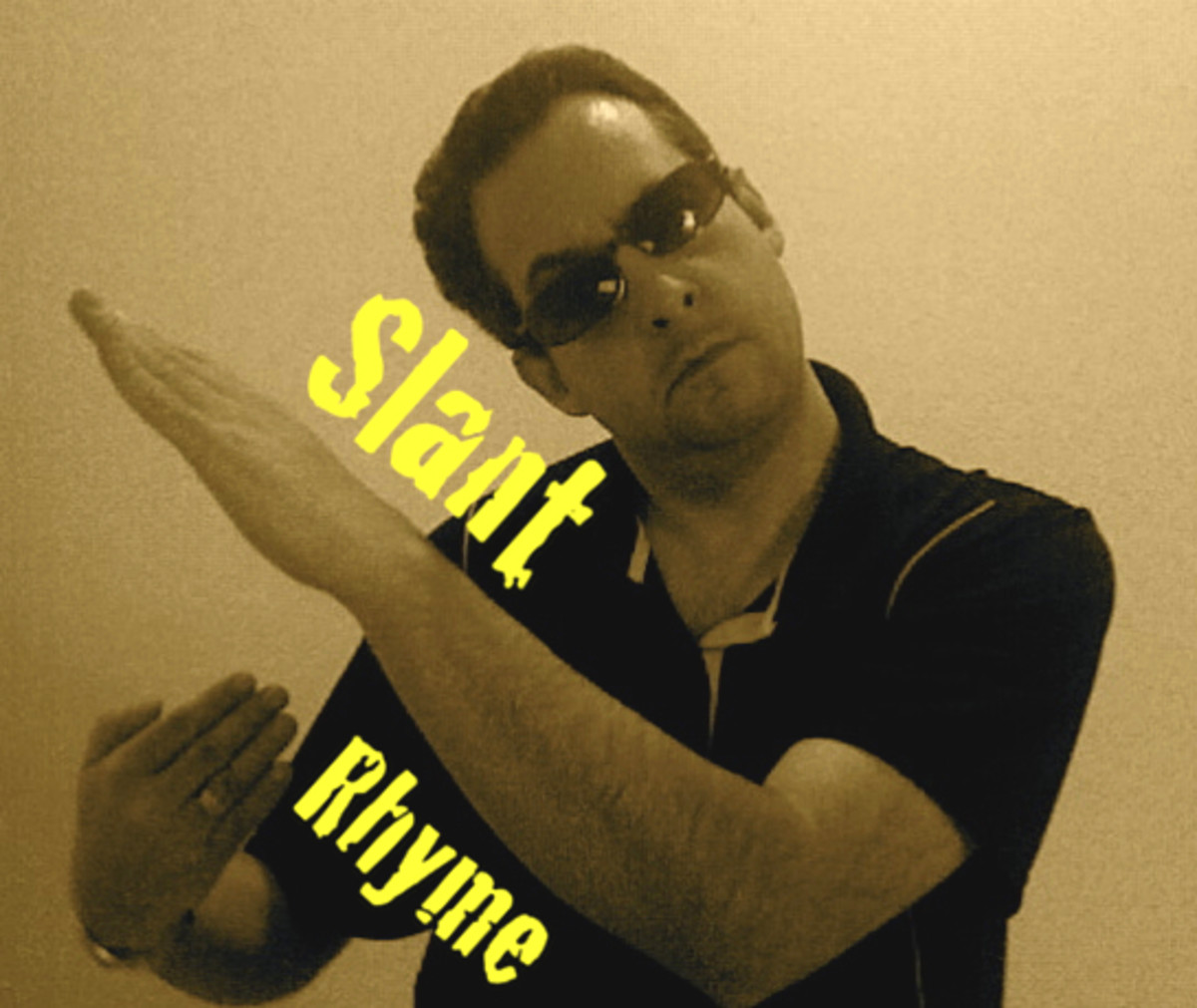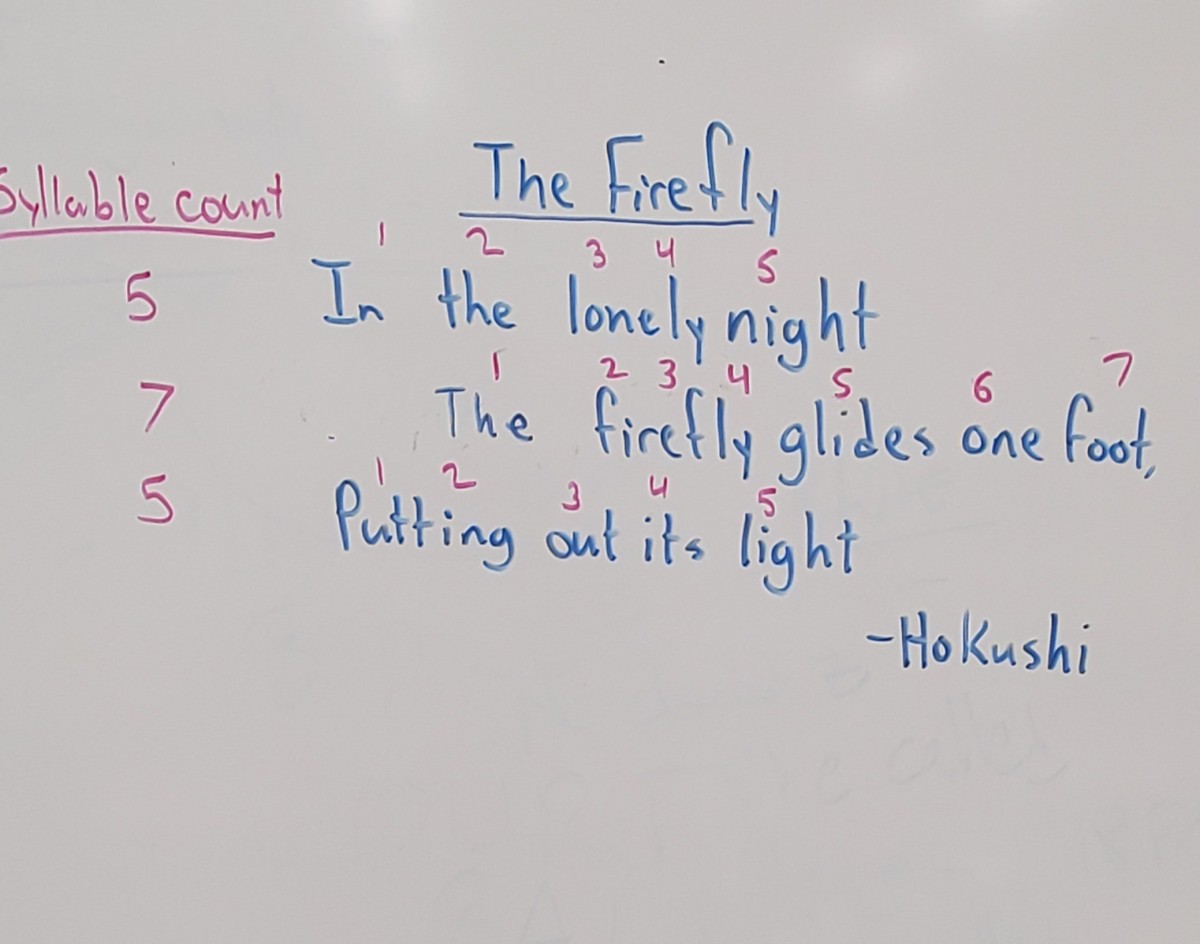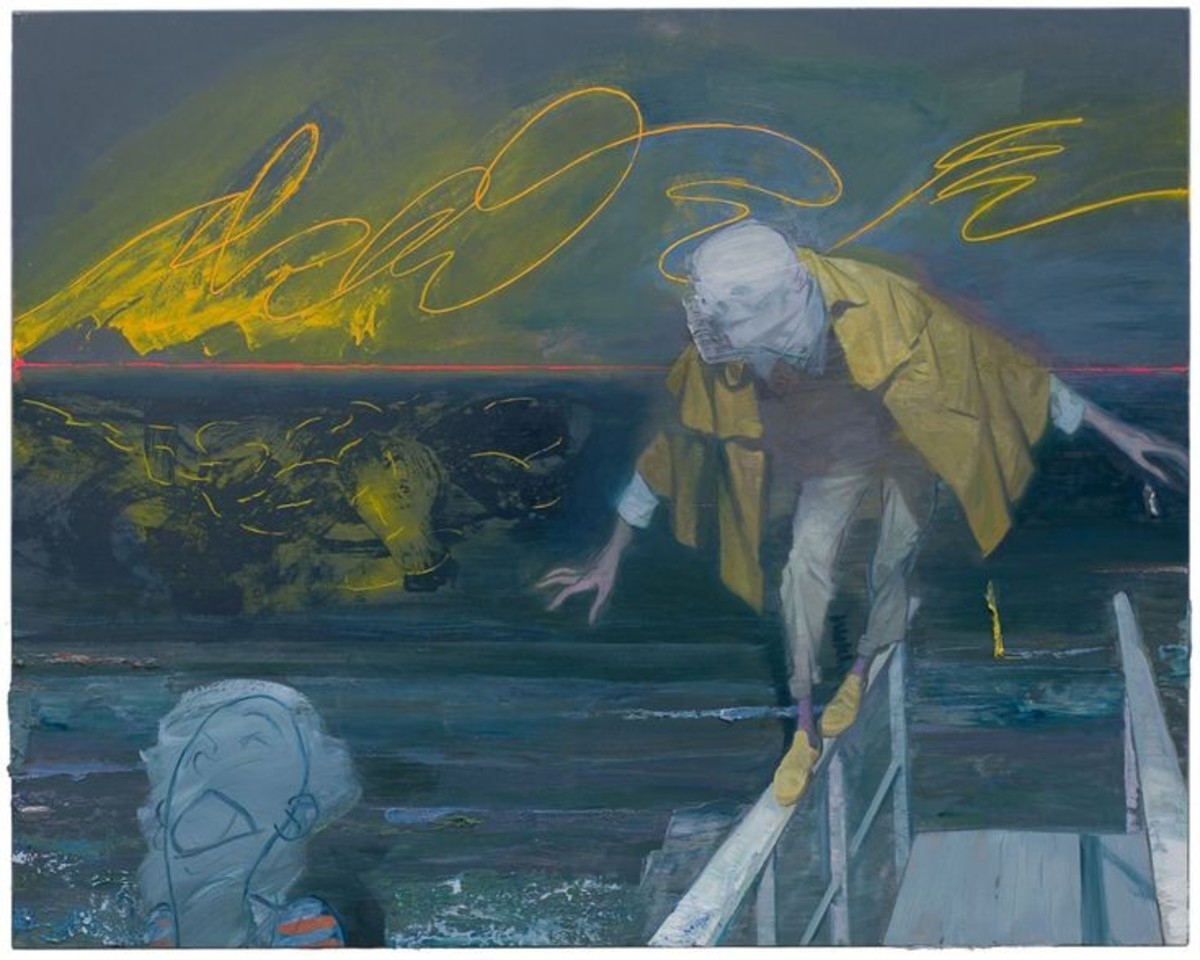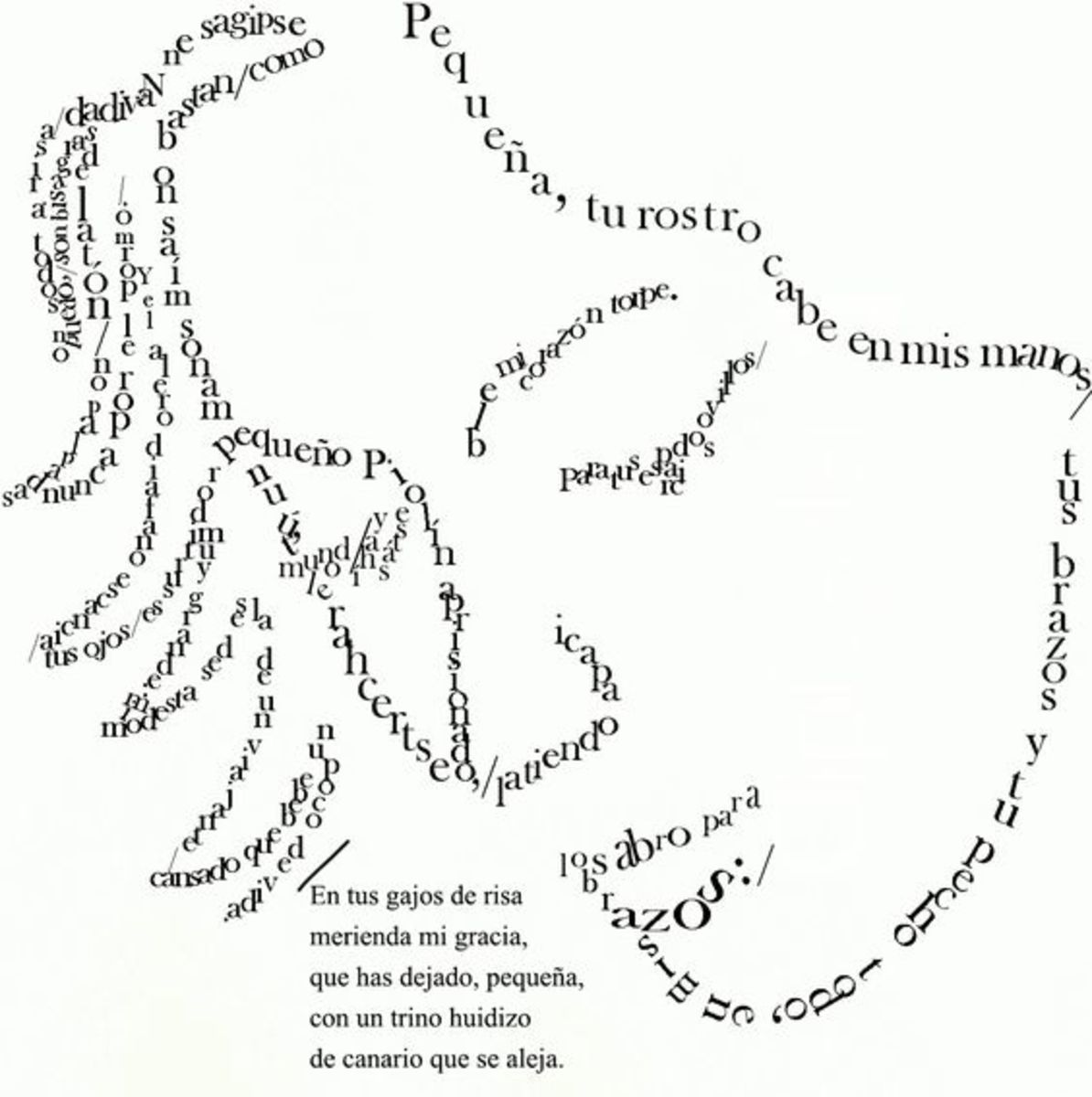Poetry- What is it?

Poetry is as old as language itself. According to Wikipedia, poetry is “An art form in which human language is used for its aesthetic qualities in addition to, or instead of, its notional and semantic content.” I interpret this to mean that the words--and the look, subtexts and backgrounds of these words-- themselves are as important as, and an extension of, the content of the poem. A poem is supposed to tell a story, image, feeling or a moral in an artistic way using all the elements of words: size, shape, placement, nuance, semantics, diction, and, yes, even literal meaning. Unlike prose, which is rectangular and has typesetting arbitrarily set by the printer, poetry's letter placement is never arbitrary and is set by the author-- and is thus deemed important to the piece itself. It's easy to identify a piece of prose by the way it looks-- but that's not always the case with poetry.
Let's look at this sentence for an example: “As the cat climbed over the top of the jamcloset, first the right forefoot, carefully, then the hind, stepped down into the pit of the empty flowerpot”. Is this simple sentence a poem? I would assert, based on the above definition that this sentence does not fit the definition of a poem, but would be considered prose. It's an interesting sentence, but it's simply describing a cat doing something naughty. It is a complete sentence that shows an image but it is not a poem.

But what if we took that same sentence, removed the punctuation and shaped it like this:
As the cat
climbed over
the top of
the jamcloset
first the right
forefoot
carefully
then the hind
stepped down
into the pit of
the empty
flowerpot
Now we see that this could qualify as a poem, based on the above given definition.In fact, this is a poem titled “As the Cat” by Modernist poet, William Carlos Williams. But how is this a poem? The words have not changed- -only the punctuation and the layout. The words are now laid out in very short fragments signifying the slow and deliberate movements of a cat, and divided into three stanzas, which increase in size as the urgency of the cat's actions are felt. You can almost see the way the words paint the picture and draw out the scene of a cat deliberately climbing into something. Using words alone, you can see how the cat lifts each paw and carefully descends into an empty flowerpot. The words create suspense by offering line and paragraph breaks (enjambments) at words/phrases like “over” “on top of” and “into”. The placement of the words is as important, if not more inportant, then the words themselves, which are actually ridiculously simple. Quite simply, the way the words look on the page tells a story and that is an essential element of poetry, and is what turns this simple sentence into a poem.
“But that doesn't rhyme, so it can't be poem,” you might be saying to yourself. While a poem needing to rhyme to be considered a poem is a common thought, it also also an incorrect one. The definition above says nothing about rhyming, and, in fact, there are cases when a rhyme scheme actually takes away from a poem's artistic qualities.
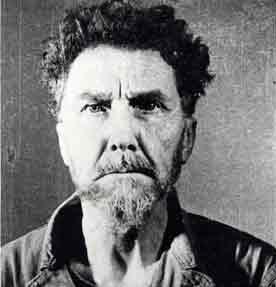

There are good reasons for this belief, however. The first poems most of us hear growing up are songs and nursery rhymes, both of which are predominately heavily and explicitly rhymed and, as our first exposure to the medium of poetry, this is how we are likely base what a poem is from an early age. Even during many poetry classes I took in grade school and junior high, rhyming was encouraged and even required for a poem to be given an “A” grade. A good poet should be able to rhyme, but a good poem does not need to rhyme.
Remember our basic definition of poetry as an art form in which human language is used for its aesthetic qualities in addition to, or instead of, its notional and semantic content, as use that to consider our next two poems.William Shakespeare is considered by many (though, not by me) as the world's greatest poet. His poems are primarily sonnets (by definition, sonnets are a rigidly structured poem, typically written in fourteen rhymes of iambic pentameter and rhymed in three quatrains and a couplet: ABAB,CDCD,EFEF,GG.). For example: “ In me thou didst see'st the glowing of such fire/ that on the ashes of his youth doth lie/as the deathbed whereon it must expire/consumed with that which it was nourished by.” We see here a very heavy ABAB rhyming pattern- and a very common, often effective, and instantly recognizable form of poetry. Contrast this with the works of one of my favorite poets, Ezra Pound. “All the while they were talking the new mortality/her eyes explored me./And when I rose to go/Her fingers were like the tissue/Of a Japanese paper napkin.” Is this also a poem? Does this fit our definition as stated above? Certainly it does!. Pound's words paint a very vivid picture of a scene he is describing, even though he does not rhyme or apply a consistent meter to his work. His words and the placement of his words are important and they have an aesthetic quality to them. Pound is just as much a poet as William Shakespeare, even though he chooses often to forsake rhyme. There are few, if any, who would argue this point. Ezra Pound and Shakespeare are generally uttered in the same breath when the greatest poets in history are discussed.
“But Pound's poems don't look or sound like poems. There's no rhythm or meter.” This is another good thought one might have about poetry, but, it is also incorrect. Again, using Shakespeare's above sonnet as an example, we see that certainly many poems do and should have a specific rhythm and meter, but, language itself has meter. It does not need to be expressed in an orderly fashion on paper. In fact as with rhyming, there are times where the apparent lack of meter and stucture gets the desired affect better then if the piece was orderly and structured.
Let's take a look at a section one of my own poems as an example:
Again
the train is stopped.
Sixty miles out of Portland
and we've been stopped
for thirty minutes.
Now we're going again,
and now we're stopped
again.
We're letting another freight train pass .
The way this poem is laid out on the page, with the enjambments and endstops, the way the poem is written represents the stops and starts of a train ride- and the shape itself with a center alignment also kind of looks like a train. Notice how the lines break at the word “stopped”, thus emphasizing the fact that the train is stopping andnot merely showing it. It's much more effective then if the same poem looked like this:
Again the train is stopped.
Sixty miles out of Portland and we've been stopped for thirty minutes.
Now we're going again, and now we're stopped again.
We're letting another freight train pass.
Or, add a few words and turn the poem into a piece of prose like this:
Again the train is stopped. We're sixty miles out of Portland and we've been stopped for thirty minutes. Finally we're moving again, only to be stopped a short time later to let another freight train pass.
The words here are telling the same story, but it's not as interesting to read or look at. It might fit in an essay about a train ride, but it doens't fit in a poetry book (You can view this poem in it's entirety here: http://hubpages.com/hub/Last-Train-to-Bellingham).
The most important element in a poem, then, is whether or not a poem forces you to stop and think about what you're reading. If the poem doens't resonate, then the poem is ineffective and may as well be, for all intents and purposes, be a generic piece of prose or even, God forbid, a book report. Even simple nursery rhymes like Ring Around the Rosey are cryptic enough that one needs to stop and think about each word:
Ring around the rosey
Pocket full of posies
Ashes
Ashes
We all fall down.
This seemingly simple nursery rhyme is actually not simple at all (nor is it even kid friendly, in spite of it's modern usage as a nursery rhyme for children). The poem recounts the Black Plague and brings to mind the following questions: Why is there a ring around the rose? What does the rose represent? What are posies and why are they in their pockets? Where did the ashes come from? Is “We all fall down”metaphorical or literal? You could say the same things this poem is saying in a simple sentence or two, but it would not be memorable and you would lose the effectiveness of the poem. The poem address the fear of dying as a result of the Black Plague even though “plague”, “fear” and “death” are not specifically mentioned. The poem is memorable because it forces you to stop and think about what the simple rhymes mean.
So, then, what is a poem? A poem is a piece of literature that can rhyme, but doens't have too. It can be very rigid and structured, or it can be apparently free of these conventions (Free Form). The important thing with a poem is the usage of words- if the words themselves can cause images and emotions to be drawn out through the authors use and placement of them. Unlike in prose, these images are shorter often more cryptic- usually much faster to read and require more thought and discussion after reading and rereading.
Poetry is hard to define- because poetry is everywhere. You just need to open your mind and see it.








